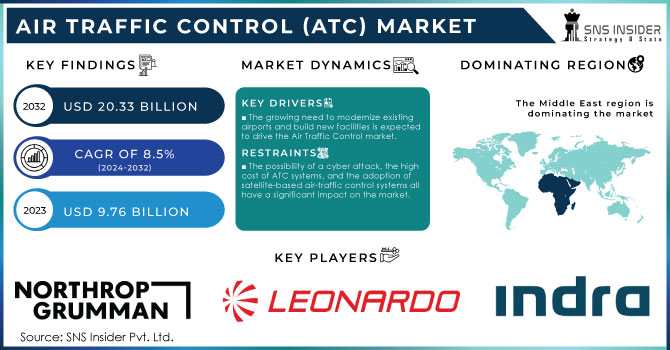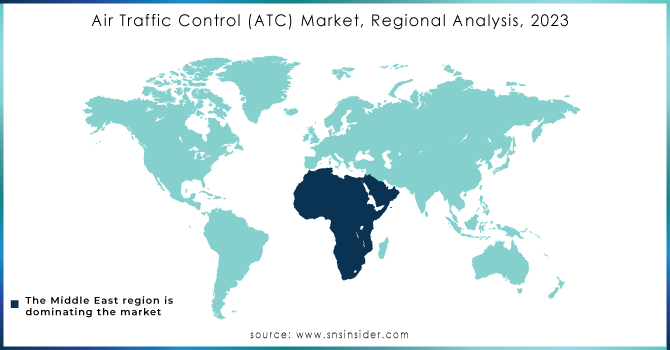Air Traffic Control (ATC) Market Report Scope & Overview:
The Air Traffic Control (ATC) Market Size was valued at USD 9.76 billion in 2023 and is expected to reach USD 20.33 billion by 2032 with a growing CAGR of 8.5% over the forecast period 2024-2032.
The Air Traffic Control Market report provides the current market size, defines trends, and forecasts growth to 2030. All market revenue figures are given in US dollars. The supply side analyses the Air Traffic Control Market, taking into account market penetration in all regions around the world. The study also provides market insights and analysis of the Air Traffic Control Market, highlighting technological market trends, adoption rate, industry dynamics, and competitive analysis of major Air Traffic Control Industry players.

To get more information on Air Traffic Control (ATC) Market - Request Free Sample Report
MARKET DYNAMICS
KEY DRIVERS
-
The growing need to modernize existing airports and build new facilities is expected to drive the Air Traffic Control market.
RESTRAINTS
-
an increase in the number of airports, the need for improved airspace management systems, and an increase in the number of passengers
-
The possibility of a cyber attack, the high cost of ATC systems, and the adoption of satellite-based air-traffic control systems all have a significant impact on the market.
OPPORTUNITIES
-
Many developing countries have plans to build new airports to improve domestic and international air travel.
-
India intends to build an additional 100 airports by the end of 2024.
IMPACT OF COVID-19
COVID-19 has the potential to have three significant effects on the global economy: directly affecting production and demand, disrupting supply chains and markets, and having a financial impact on businesses and financial markets. Our analysts, who are monitoring the situation around the world, believe that the market will provide producers with profitable opportunities in the aftermath of the COVID-19 quandary.
The market for air traffic control is divided into four segments: communication, navigation, surveillance, and automation. During the forecast period, the automation segment is expected to grow at a higher CAGR of 6.8% in the Air traffic control Market. It is rapidly expanding as airports and air traffic controllers engage in simulations, and it is being fueled by the increased use of remote towers. As a result, during the forecast period, this major factor will drive the growth of the automation segment in global air traffic control.
The market is divided into three categories based on airport size: small, medium, and large. The large segment is expected to be the fastest-growing market segment during the forecast period. This expansion can be attributed to the increasing demand for the installation of advanced security systems in airports, as well as the demand for system customization around the world. The medium segment, on the other hand, was the largest.
Increased demand for airport ground support services will propel the ATCT segment. The market is divided into four categories based on airspace management: Air Route Traffic Control Centers (ARTCC), Terminal Radar Approach Control (TRACON), Air Traffic Control Tower (ATCT), and Remote Tower (RT). The air traffic control tower (ATCT) segment is expected to be the market's fastest-growing segment during the forecast period. This expansion is attributed to increasing airport fleets and ground support systems at airports, with the ARTCC segment being the largest.
KEY MARKET SEGMENTATION
By Airport Size
-
Large
-
Medium
-
Small
By Airspace
-
ARTCC
-
TRACON
-
ATCT
-
RT
By Application
-
Communication
-
Navigation
-
Surveillance
-
Automation
By Offering
-
Hardware
-
Software
-
Services
By Sector
-
Commercial
-
Military & Defense
REGIONAL ANALYSIS
From 2024 to 2032, the Middle East air traffic control market is expected to grow at the fastest CAGR. This expansion is primarily due to the modernization of airport infrastructure, which has led to increased procurement of air traffic control equipment to streamline flight operations. Increased passenger traffic through the Middle East region has increased demand for air traffic services.
The UAE is a major contributor to the Middle East market's growth. Given the number of airports and rising passenger traffic, the country leads the global market. In addition, the construction of a new airport in the countries under consideration for the study is important because new airports will necessitate the installation of a control tower. These control towers will be outfitted with all the latest systems.

Need any customization research on Air Traffic Control (ATC) Market - Enquiry Now
REGIONAL COVERAGE:
-
North America
-
USA
-
Canada
-
Mexico
-
-
Europe
-
Germany
-
UK
-
France
-
Italy
-
Spain
-
The Netherlands
-
Rest of Europe
-
-
Asia-Pacific
-
Japan
-
south Korea
-
China
-
India
-
Australia
-
Rest of Asia-Pacific
-
-
The Middle East & Africa
-
Israel
-
UAE
-
South Africa
-
Rest of Middle East & Africa
-
-
Latin America
-
Brazil
-
Argentina
-
Rest of Latin America
-
KEY PLAYERS
The Major Players are Indra Sistemas SA, Leonardo S.p.A, Northrop Grumman Corporation, Raytheon Technologies Corporation, Saab AB, Sky Soft-ATM, Thales Group, Adacel Technologies Limited, BAE Systems, Frequentis AG, and other players
| Report Attributes | Details |
|---|---|
| Market Size in 2023 | USD 9.76 Billion |
| Market Size by 2032 | USD 20.33 Billion |
| CAGR | CAGR of 8.5% From 2024 to 2032 |
| Base Year | 2023 |
| Forecast Period | 2024-2032 |
| Historical Data | 2020-2022 |
| Report Scope & Coverage | Market Size, Segments Analysis, Competitive Landscape, Regional Analysis, DROC & SWOT Analysis, Forecast Outlook |
| Key Segments | • By Airport Size (Large, Medium, and Small) • By Airspace (ARTCC, TRACON, ATCT, RT) • By Application (Communication, Navigation, Surveillance, Automation) • By Offering (Hardware, Software, Services) • By Sector (Commercial, and Military & Defense) |
| Regional Analysis/Coverage | North America (USA, Canada, Mexico), Europe (Germany, UK, France, Italy, Spain, Netherlands, Rest of Europe), Asia-Pacific (Japan, South Korea, China, India, Australia, Rest of Asia-Pacific), The Middle East & Africa (Israel, UAE, South Africa, Rest of Middle East & Africa), Latin America (Brazil, Argentina, Rest of Latin America) |
| Company Profiles | Indra Sistemas SA, Leonardo S.p.A, Northrop Grumman Corporation, Raytheon Technologies Corporation, Saab AB, Sky Soft-ATM, Thales Group, Adacel Technologies Limited, BAE Systems, Frequentis AG, and other players. |
| DRIVERS | • The growing need to modernize existing airports and build new facilities is expected to drive the Air Traffic Control market. |
| RESTRAINTS | • an increase in the number of airports, the need for improved airspace management systems, and an increase in the number of passengers • The possibility of a cyber attack, the high cost of ATC systems, and the adoption of satellite-based air-traffic control systems all have a significant impact on the market. |

